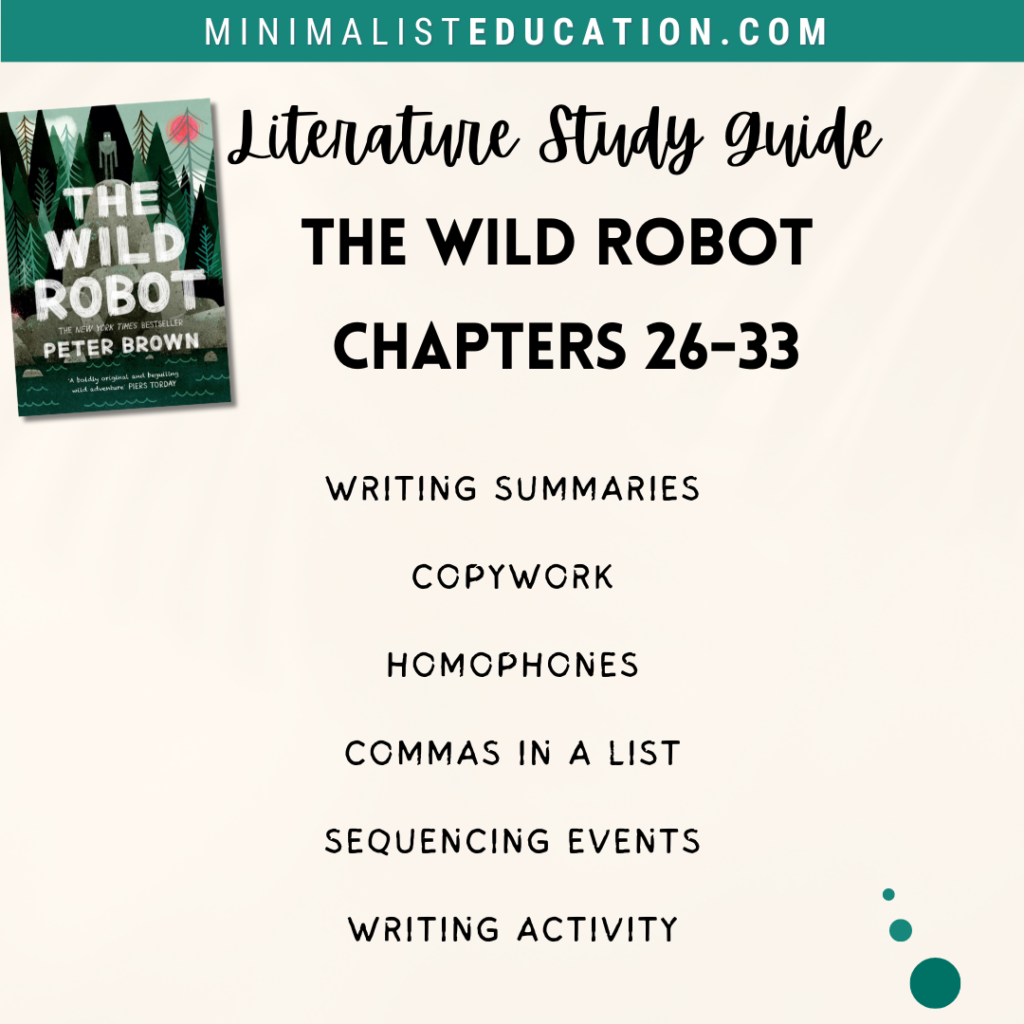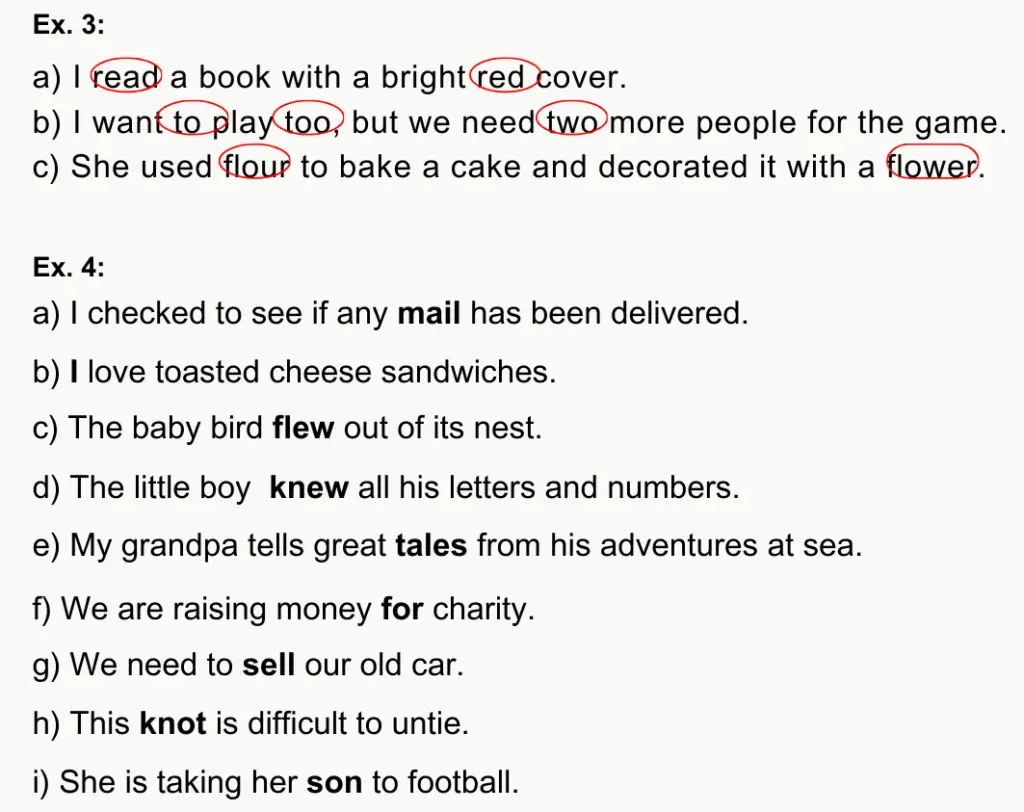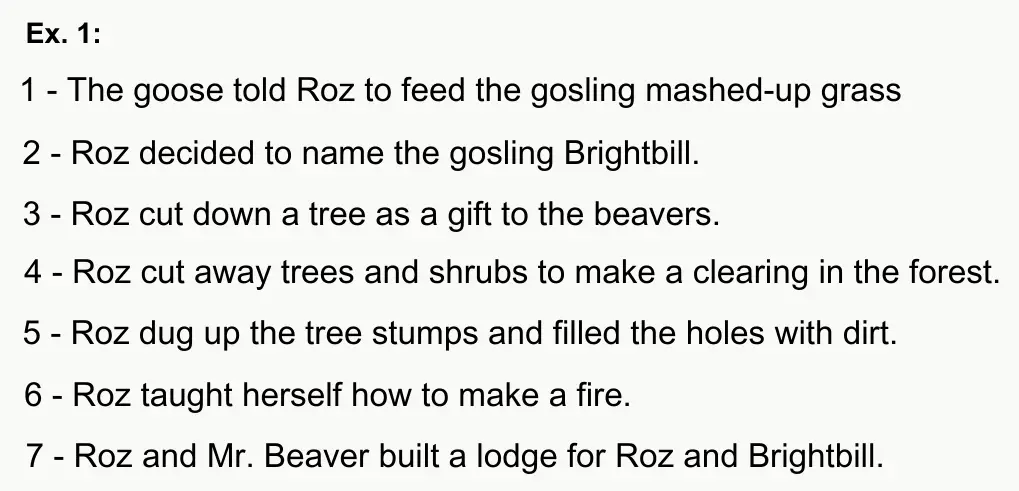Writing Summaries: The Wild Robot Chapters 26-33 Study Guide
This post contains paid links. I may get a commission if you decide to make a purchase through my links, at no extra cost to you. Thank you for helping towards the cost of hosting and maintaining this website.

Now that the Non-Chronological writing project is completed we can turn all of our attention back on the story. This week we will be focusing on the ever important skill of giving and writing summaries. We will also be sequencing events, focusing on using comas when listing, and homophones.
Writing summaries can be a difficult skill for even adults. A lot of brain power goes behind effective summaries. It is a skill that requires thought and practice, so don’t worry too much if the responses are not what our matured and multiple decades (for some of us at least) of living and experience come up with.
If this is your first visit, you can access all of the weekly The Wild Robot study guides here.
Get your copy of The Wild Robot:
Buy a copy of “The Wild Robot” (Amazon Link).
In this post:
- The Wild Robot teaching notes and answers for Week 6 Chapters 26-33
- Download The Wild Robot Study Guide for Week 6 Chapters 26-33
The Wild Robot Chapters 26-33 Study Guide Teaching Notes and Answers
Chapters 26-27
Writing Summaries
- Read the explanation text on writing summaries.
- Ex. 1 Read Chapter 26 of The Wild Robot. Have a go at telling someone a summary of Chapter 26 in two or three sentences.
- Ex. 2 Read Chapter 27 and this time write down your summary of this chapter.
The first two exercises jump straight into doing summaries. A summary is a short and quick version of a story. Make sure your child understand that summaries are different from re-tellings or narrations.
When they summarise or write a summary, they pick out the most essential things that happened in the story. They need to think about the main characters, where and when the main event took place, and the most important thing that they did or what happened to them.
I started off giving a non-example of a summary by starting to retell my morning:
“My alarm went off. After 10 seconds I turned it off. I sat up in bed. I put my right foot on the floor. Then I…”
The kids understood pretty quickly the point of a summary and how it should only include the most important, significant things.
However, understanding the purpose of a summary and actually being able to summarise are two different things. I’ve mentioned already how it’s not an easy skill and requires practice to master. This is because it requires analysing all of the information and making judgements about what is and isn’t important.
For some kids it may take a bit of discussion to figure out the main event and idea in a chapter. Most likely they will use the part they found most interesting as as summary, or the last thing that was read!
Writing Summaries Using the “5 W” Questions: Who? What? When? What? Why?
A quick way to help children summarise fiction work is to use the “5 W questions”- Who? What? When? Where? Why?
It helped my kids to hone in on the single event that was significant in the chapters.
For a summary at the chapter or paragraph level, kids can think about:
Who was the main character in this part of the story?
What happened that made the chapter end the way it did? This part might require kids to retell some of the big events, and then work out what the most important event was.
When and where is about the setting of the story at that point.
Why relates to the what. It is the reason the “what”, the main thing in that part of the story, happened.
And then using the responses to the 5 W questions, they can say or write their summary in a format similar to:
“This chapter is about —who–. It takes place —when and where–. —what— because —why–”
Homophones
- Read the explanation text and example on homophones.
As if spelling correctly wasn’t hard enough, there’s a whole group of words that sound the same but have different spellings.
For this weeks spelling practice, we are going to focus on homophones. There are too many to cover, but it is really important for kids to be aware of homophones and play around with some examples.
The example sentence from chapter 27 of The Wild Robot:
“Roz needed to find a grown goose.”
This sentence has two words, each of which have homophones.
The word “to” sounds the same as “too” and “two”.
The word “grown” sounds the same as the word “groan”.
If we rewrote the sentence using the homophones:
“Roz needed too find a groan goose.”
It would sound the same when read aloud, but makes no sense at all!
- Ex. 3 Circle the homophones that appear in the following sentences.
- Ex. 4 Fill in the blank with the correct word to complete each sentence.

This study guide will have a cyclical nature, meaning I will be returning to a lot of the topics again, so I have kept this week’s exercises on homophones brief.
If you wanted to practice homophones a bit more, be sure to check out my homophones worksheet and teaching ideas.
Chapters 28-31
- Read chapters 28-31.
- Number the events in the correct order. Draw a picture of your favourite event.

In this exercise, kids will read all of the sentences and try to recall the order in which they happened.
The ability to sequence events in a text is a key comprehension strategy, especially for narrative texts. It’s also a skill that helps children to grasp the cause-and-effect relationships between different events.
Chapters 32-33
- Read chapters 32 – 33.
- Read the selected passage and explanation notes for using commas in a list.
- Ex. 1 Copywork the selected extract.
- Ex. 2 Add commas where needed in the sentences given.
- Ex. 3 Write a list of the things you would pack for going to the different destinations given.
This week’s grammar focus is using commas when listing in a sentence. Note that the items listed can be single words as in “I bought milk, eggs and flour” or as phrases and clauses as in “I cleaned my room, did the dishes and mopped the floor.
Commas are used to separate items in a list in a sentence, but before the last two items of the list you don’t need a comma, instead use ‘and’ or ‘or’.
In the selected extract:
“After some pleasant conversation, each neighbour would choose their spot, leave their droppings, and be on their way.” (The Wild Robot Chapter 33 page 94)
the commas separate the three distinct actions the animals take.
They:
- “choose their spot”
- “leave their droppings”
- “be on their way”
Notice how ‘and’ is used in between the last two actions in the list.
The first exercise is copywork. This will give children a chance to practice using commas from a model.
Exercise 2 requires kids to consider for themselves where the commas need to go.

- Exercise 3 gets the kids to practice using commas in a list in their own sentences.
It might be useful to share some examples of how ambiguity and confusion can arise if these commas aren’t used. For example, in the sentence:
“I had chocolate raisins coffee cake and crisps.”
Did I have chocolate and raisins and coffee and cake and crisps?
Or did I have chocolate raisins and coffee and cake and crisps?
Or did I have chocolate raisins and coffee cake and crisps?
Download Your Copy of The Wild Robot Study Guide for Chapters 26-33:
I hope this helps some of you out!
Leave a Reply